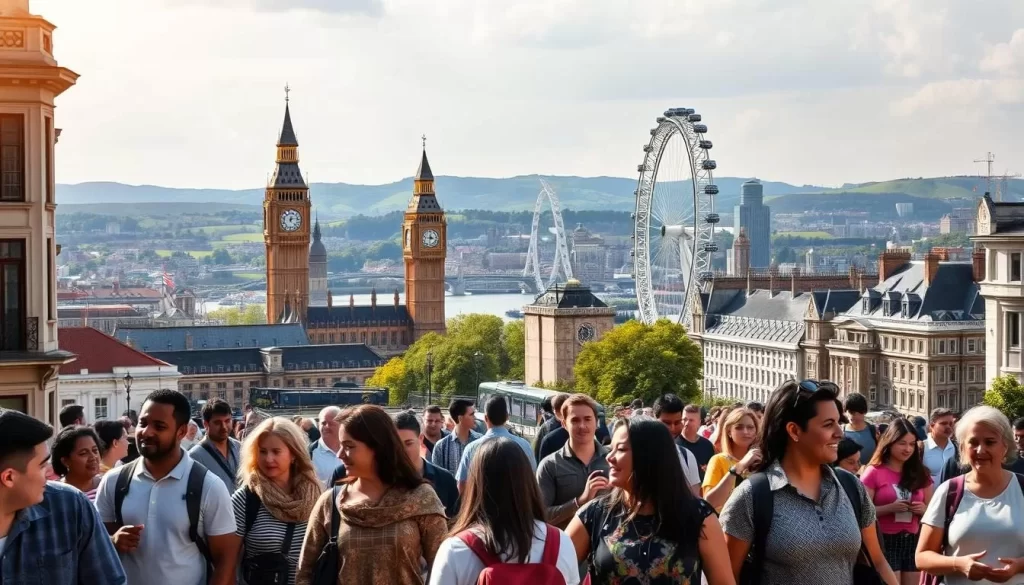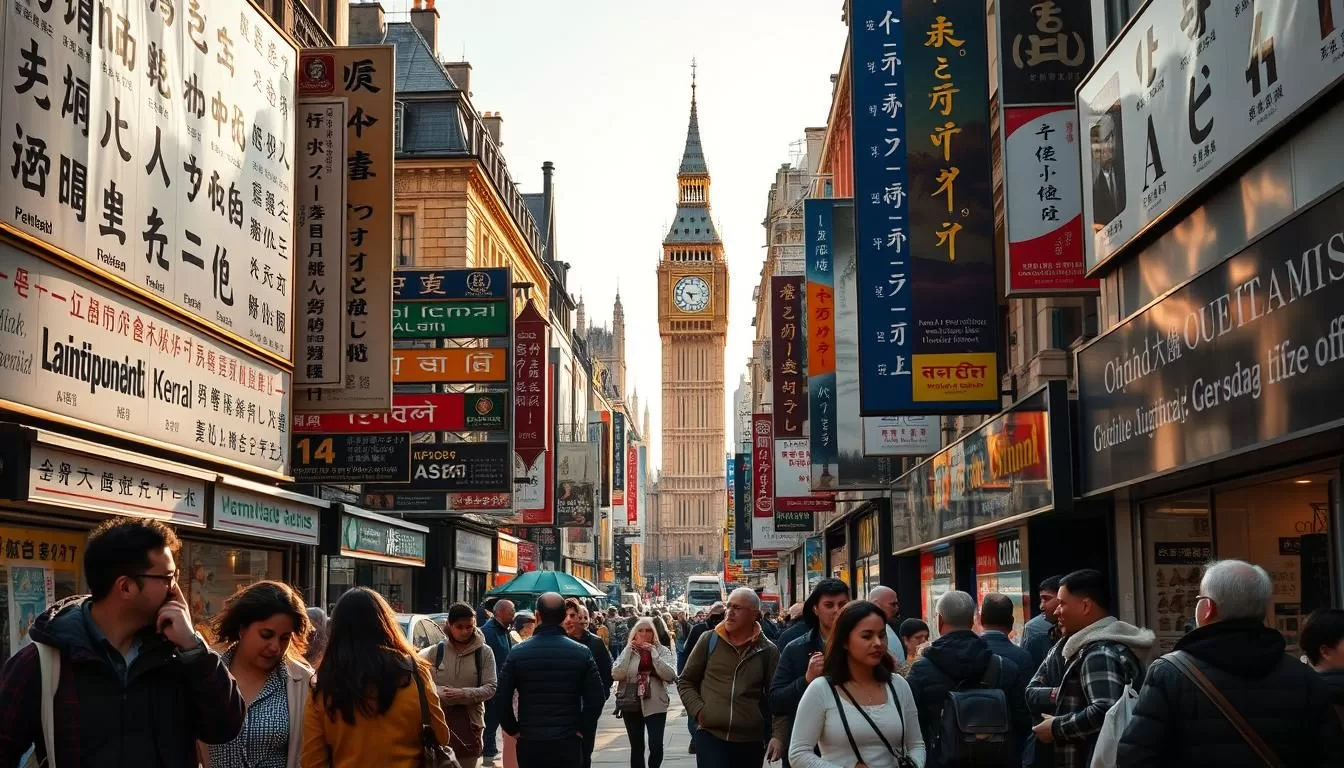When you think of the UK, English likely comes to mind as the main language. It’s the most common way people communicate, shaping the country’s identity. But did you know that the linguistic landscape here is far more diverse?
While English dominates, many other languages thrive across different regions. From indigenous dialects like Welsh to immigrant languages such as Polish, the UK is a melting pot of cultures. This mix reflects the rich history and multicultural nature of the country.
For residents, language is more than just a way to speak. It’s a part of their heritage and daily life. Whether it’s a family passing down their native tongue or a child learning a second language, these practices keep communities vibrant and connected.
Exploring the linguistic diversity of the UK offers a fascinating glimpse into its culture. It’s a reminder that language is a powerful tool, shaping how people live, work, and connect.
Overview of Language Diversity in the United Kingdom
The UK’s linguistic landscape is a vibrant mix of history and modernity. From ancient roots to contemporary shifts, the way people communicate here has evolved significantly. This section dives into the historical context and modern demographic trends that shape the country’s language diversity.

Historical Context and Evolution
Centuries ago, the Anglo-Saxon settlement laid the foundation for English as we know it. Later, the Norman Invasion introduced French influences, blending with local dialects. Over time, these interactions transformed early language forms into modern English and regional variations.
For example, the Welsh language has persisted in Wales, a testament to the resilience of indigenous cultures. Similarly, Scots and Cornish dialects have maintained their presence, enriching the UK’s linguistic heritage.
Modern Demographic Overview
Today, the UK’s population reflects a dynamic mix of languages. Census data shows that while English remains the main language for most residents, other languages thrive. Polish, for instance, is the most commonly spoken non-English language, followed by Panjabi and Urdu.
Communities across the country continue to preserve their native tongues. Whether it’s a family speaking Bengali at home or a person learning British Sign Language, these practices keep cultures alive. Regional variations also play a part, with cities like Leicester and Manchester hosting diverse linguistic communities.
Understanding this diversity helps you appreciate how language shapes identity and connection in the UK. It’s a fascinating blend of the old and the new, reflecting the country’s rich cultural tapestry.
United Kingdom: Official and Widely Spoken Languages
English is the backbone of communication in the UK, but its linguistic landscape is far from uniform. While it’s the main language for most residents, other languages and dialects add depth to the country’s cultural identity.
English as the De Facto Official Language
English holds a unique position in the UK. Despite not being formally declared the official language, it’s the primary way people communicate. Census data shows that over 98% of residents speak English as their first or second language.
This dominance stems from historical roots. Over centuries, English evolved into the main language of government, education, and daily life. Today, it’s the glue that connects people across different regions and communities.
Regional and Minority Variations
While English is widespread, regional and minority languages thrive in specific areas. For example, in Northern Ireland, Irish and Ulster Scots are part of the local heritage. These dialects reflect the unique histories of their speakers.
Other regions also preserve their linguistic roots. Welsh, for instance, is widely spoken in Wales, while Scots remains a vibrant dialect in Scotland. These languages are more than just ways to communicate—they’re symbols of cultural pride.
Understanding these variations helps you appreciate the UK’s rich linguistic tapestry. It’s a reminder that while English is the main language, it’s not the only one shaping the country’s identity.
Indigenous Languages of the UK
Beyond English, the UK is home to several native languages with deep historical roots. These languages are more than just ways to communicate—they’re symbols of cultural pride and identity. From Welsh in Wales to Cornish in Cornwall, each language tells a story of resilience and heritage.

Welsh and Its Legal Recognition
Welsh is a legally recognized language in Wales, with around 900,000 speakers today. Its status ensures it’s used in education, public signage, and government. This recognition reflects the importance of preserving cultural identity.
For example, nearly 25% of school pupils in Wales are educated through Welsh. This approach not only keeps the language alive but also strengthens community bonds. Public signage in Wales often includes both English and Welsh, making it a visible part of daily life.
Scottish Gaelic, Scots, and Cornish
In Scotland, Scottish Gaelic and Scots are integral to the region’s identity. Around 61% of the population in the Outer Hebrides speak Scottish Gaelic. Scots, a distinct dialect, is widely used in everyday conversations.
Cornish, once spoken locally in Cornwall, is now part of revitalization efforts. While specific speaker numbers are limited, every person who learns Cornish helps keep it alive. These languages are a testament to the UK’s rich linguistic heritage.
| Language | Region | Approximate Speakers |
|---|---|---|
| Welsh | Wales | 900,000 |
| Scottish Gaelic | Scotland | 61% of Outer Hebrides |
| Cornish | Cornwall | Limited, revitalization ongoing |
These indigenous languages are more than just words—they’re a connection to history and culture. Whether it’s a child learning Welsh or a community preserving Cornish, these efforts enrich the UK’s cultural fabric.
Immigrant and Community Languages Shaping the UK
The UK’s linguistic diversity is shaped by waves of immigration, bringing new voices to the mix. Over the years, communities from across the globe have settled here, enriching the country’s cultural fabric. This section explores how immigrant languages have become a vital part of the UK’s identity.

The Rise of Polish and Other European Languages
Polish is now the second most spoken language in the UK, with over 686,000 speakers. This growth reflects the significant number of Polish immigrants who arrived in the early 2000s. Cities like London and Manchester have thriving Polish communities, where the language is preserved through schools, media, and cultural events.
Other European languages, such as Romanian and Lithuanian, also play a role. These languages are often spoken within families, helping to maintain cultural ties. Community networks and local organizations ensure these languages remain a vibrant part of the UK’s linguistic landscape.
Urdu, Punjabi, and South Asian Contributions
South Asian languages like Urdu and Punjabi have a strong presence in the UK, thanks to mid-20th century migration. Over 269,000 people speak Urdu, while Punjabi is spoken by around 273,000. These languages are particularly prominent in cities with large South Asian populations, such as Birmingham and Leicester.
Community media, religious institutions, and cultural festivals help preserve these languages. For many families, speaking Urdu or Punjabi at home is a way to pass down traditions and strengthen cultural identity. This language preservation is a testament to the resilience of immigrant communities.
Immigrant languages are more than just a way to communicate—they’re a bridge to heritage and identity. Whether it’s a person speaking Polish at work or a family sharing stories in Punjabi, these languages enrich the UK’s cultural mosaic. To learn more about how multilingualism fosters social cohesion, check out this report.
Language Usage Trends and Cultural Influences
Language trends in the UK reveal a dynamic interplay between tradition and modernity. From bilingual education programs to heritage language initiatives, these shifts reflect how language shapes national identity and education. Understanding these trends offers insight into the cultural fabric of the country.

Impact on National Identity and Education
Language plays a crucial role in shaping national identity. For many, it’s a part of their cultural heritage. Bilingual education programs, for example, help preserve this connection. Schools across the UK are increasingly offering courses in regional dialects and immigrant languages.
These initiatives not only enhance language proficiency but also foster social cohesion. A person who speaks multiple languages often feels a stronger sense of belonging. This is particularly evident in regions like Northern Ireland, where Irish and Ulster Scots are integral to local identity.
“Language is the road map of a culture. It tells you where its people come from and where they are going.”
Heritage language programs are another key trend. They encourage families to pass down their native tongues. This practice strengthens community bonds and ensures cultural traditions endure. For instance, the number of Welsh speakers has grown due to such efforts.
Language trends also influence policy updates. Governments are recognizing the importance of inclusive language policies. These changes reflect the evolving needs of a diverse population. To learn more about how language shapes culture, visit this resource.
Successful language revitalization efforts, like those for Cornish, inspire similar initiatives. They demonstrate how a community can preserve its linguistic heritage. These examples highlight the power of language in shaping identity and connection.
Conclusion
Language is a powerful thread weaving through the cultural fabric of the UK. While English remains the main language, the country’s linguistic diversity tells a richer story. From indigenous dialects like Welsh to immigrant contributions such as Polish, each language adds depth to the national identity.
Historical and demographic shifts have shaped this landscape. Regions like Northern Ireland preserve unique dialects, while urban centers thrive with immigrant communities. These languages are more than just tools for communication—they’re symbols of heritage and connection.
Understanding this diversity helps you appreciate the UK’s cultural tapestry. Whether it’s a person speaking their native tongue or a community revitalizing an ancient dialect, these efforts enrich the nation’s identity. For more insights into the evolution of English, explore this resource.
As you reflect on the UK’s linguistic landscape, remember that language is more than words—it’s a bridge to history, culture, and belonging.
The above is subject to change.
Check back often to TRAVEL.COM for the latest travel tips and deals.
Here are some Tours & Sightseeing suggestions that might pique your interests!





